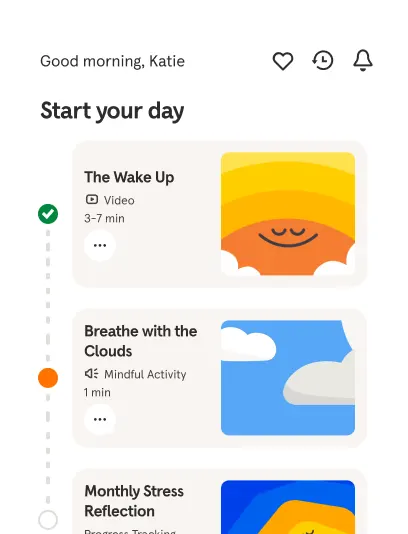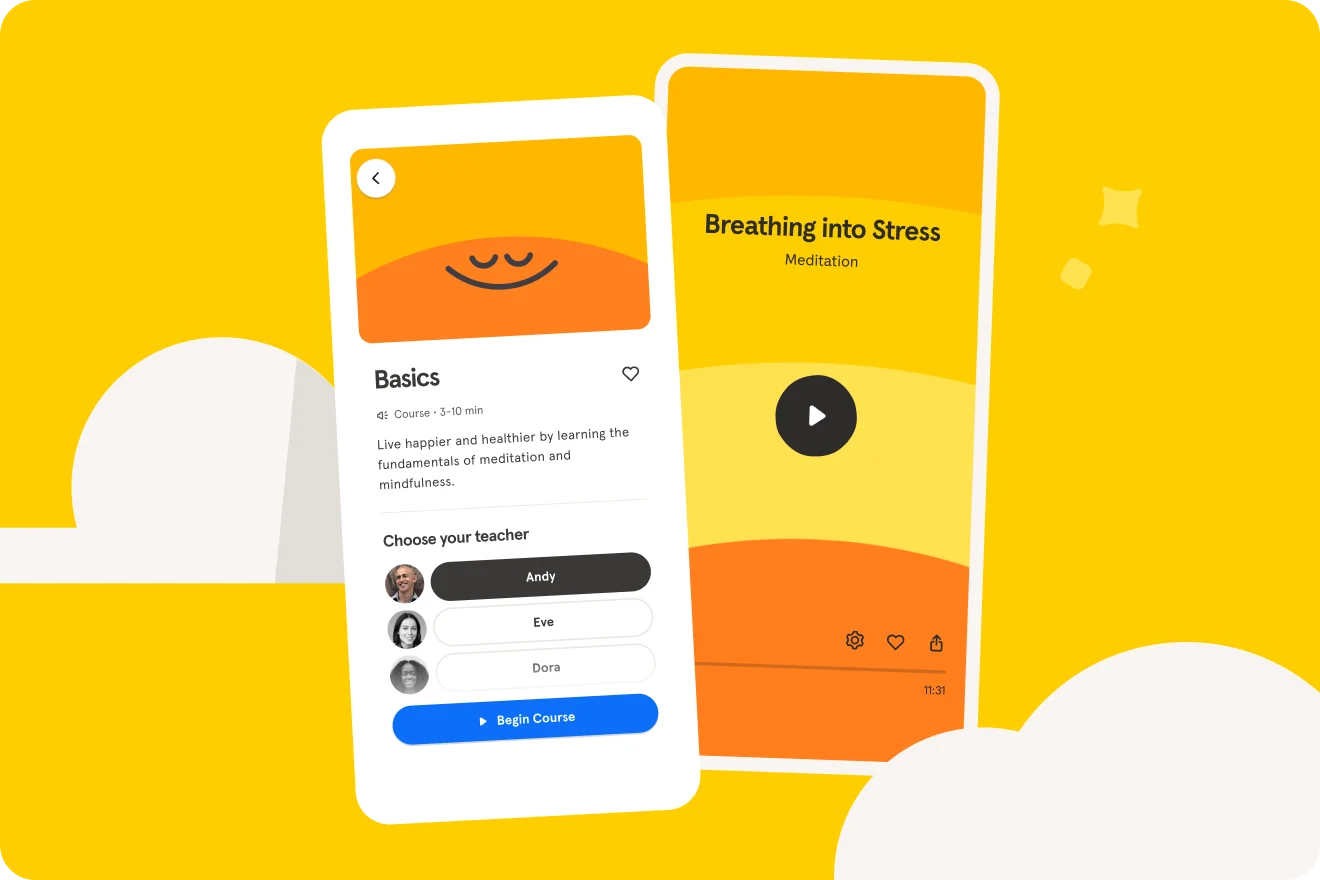Finding Calm
Find a sense of inner peace, using the box-breathing technique to create calm in the mind and body.
Try 14 days freeBetter mental health starts with Headspace. Unrivaled expertise to make life feel a little easier, using guided meditations, mindfulness tips, focus tools, sleep support, and dedicated programs.
Try 14 days free
We don't have to search far and wide for calm. It dwells within each in breath and each out breath. Just beyond the clouds are those beautiful blue skies, those qualities of calm, clarity, and balance. They're always there, but when things get chaotic, we tend to forget, and that's okay. A simple deep breath can remind us. So in this practice, we'll use the breath as a way to connect to a greater sense of calm in the mind and body. Box breathing can allow us to ride the gentle waves of the mind. Especially if we find ourselves lost in the sea of our thoughts. In this practice, we'll be breathing in for four, holding the breath for four, breathing out for four, and holding again for four, but don't worry, I'll be here to guide you every step of the way. One thing to note is as we do this breathing exercise, it's important that we're breathing into the stomach, which ensures that we're breathing deeply. So if you're sitting upright, make sure the spine is tall, shoulders relaxed, feet planted firmly onto the floor. Your hands can be resting on the legs, or down by the sides. And if you're lying down, allowing the feet to turn outwards, arms resting a few inches away from the body. Keeping the eyes open to begin to a soft downward gaze. And when you're ready, taking some nice deep breaths, in through the nose, and out through the mouth. And as you exhale, returning the breath back to its natural rhythm, and closing the eyes if you'd like. Gently noticing the body now, and where it feels a bit tense, tight, or where it feels more relaxed and more open. Scanning down, starting from the head, or scanning up, starting at the feet. Now bringing the focus to the breath, and just noticing each inhale, and each exhale. Noticing the beginning of the inhale, and the ending of the exhale, riding the wave of the breath. And if at any time, the mind wanders, that's okay. Just gently guiding it back to the breath. Now we'll begin with the box breathing. If you'd like, you can place a hand on your stomach to help feel the sensation of the breath in the body. So breathing in through the nose for one, two, three, four, and holding the breath for one, two, three, four. Breathing out through the mouth for one, two, three, four, and holding the breath for one, two, three, four. The breath shouldn't feel uncomfortable or rushed, but if it does, maybe changing the count to three, or just taking those nice deep breaths that we did at the beginning of the practice. So again, breathing in for one, two, three, four, holding for one, two, three, four. Breathing out, one, two, three, four, and holding, one, two, three, four. Breathing in deeply into the belly, and softly out through the mouth. Breathing in, one, two, three,...
Details
About your teachers
- More about Andy
A former Buddhist monk, Andy has guided people in meditation and mindfulness for 20 years. In his mission to make these practices accessible to all, he co-created the Headspace app in 2010.
- More about Eve
Eve is a mindfulness teacher, overseeing Headspace’s meditation curriculum. She is passionate about sharing meditation to help others feel less stressed and experience more compassion in their lives.
- More about Dora
As a meditation teacher, Dora encourages others to live, breathe, and be with the fullness of their experiences. She loves meditation’s power to create community and bring clarity to people’s minds.
- More about Kessonga
Kessonga has been an acupuncturists, therapist, and meditation teacher, working to bring mindfulness to the diverse populations of the world.
- More about Rosie
Rosie Acosta has studied yoga and mindfulness for more than 20 years and taught for over a decade. Rosie’s mission is to help others overcome adversity and experience radical love.

Your lifelong guide to better mental health
Stress, sleep, and all the challenging emotions — care for your mind with the everyday mental health app that's shown to make a difference.
Try 14 days free
Look after your mind
Proven guided meditations and programs to help you stress less, sleep more soundly, and better navigate life’s challenges

Science-backed
Studies show that using Headspace for 30 days can reduce stress, increase resilience, and improve overall well-being

Explore 1000+ expert-led exercises
Access our library of meditations, breathing exercises, and guidance videos for stress, sleep, focus, everyday anxiety , parenting, and more.
Member reviews
Hear from some of our members
Your app brings so much peace and tolerance to our home.
Rachel
UK
Changing my thoughts has allowed me to change my life.
Davide
London
The stress and loneliness courses … taught me how to comfort myself.
Alicia
Canada
Headspace provides me with … a connection to myself, and a disconnection from negative thoughts, feelings, and sensations.
Keri
UK
Frequently asked questions
The physiological effects of stress are understood — it stimulates the sympathetic nervous system, causing a release of stress hormones (epinephrine and cortisol) into the bloodstream. None of that is good for blood pressure, heart health, blood sugar levels, or the immune system. But when we choose to relax mind and body through meditation, the parasympathetic nervous system is instead stimulated and this stops stress hormones being released, so you will naturally feel less stressed. This is the benefit of a calming meditation, essentially soothing the nervous system and allowing you to breathe easier and feel more relaxed, therefore lowering your blood pressure and heart rate.
Most people feel a little more calm, grounded, and relaxed after meditation. Why? Because when anyone is stressed or overwhelmed, their sympathetic nervous system is stimulated, causing a release of stress hormones (epinephrine and cortisol) — blood pressure goes up, heart rate increases, and the breath can become shallow. When you meditate, the parasympathetic nervous system is instead stimulated and that stops stress hormones being released. Research shows that a calming meditation leads to reduced stress. A 2018 study found that medical students saw a 12% decrease in stress after using the Headspace app to meditate for just 10 days. That same study found that participants who used the app for 30 days saw stress levels reduced by a third.
The Headspace app has its own teachers that lead this calming meditation, guiding you step by step. But in short, the key to calming the mind is to sit somewhere comfortable, hands in your lap, and then take five, deep breaths — in through the nose, out through the mouth — before closing your eyes. You will use the breath as your object of focus; in other words, this is where you will place your attention. It can help to begin silently counting those breaths: 1 as you inhale, 2 as you exhale, 3 as you inhale, 4 on the exhale, and so on, up to 10 … and repeat. There is nothing “to do '' except guide your attention back to the breath each time the mind gets distracted by a thought. This is a quick calming meditation that can take us out of a spiral of thoughts and bring us back to the present, as and when needed.
A calming meditation is a good way to feel less anxious/stressed in the moment. It is a technique that involves placing your attention on an object of focus — the breath, a visual image, or an actual object — to cultivate a state of mental calm and stability. The practice involves teaching the mind to let go of distracting thoughts by placing attention on the object of focus whenever the mind wanders. The Headspace app incorporates a calming meditation into many of its in-app exercises, and one popular exercise is this Finding Calm meditation — an eight minute meditation that uses the box breathing technique.
- © 2024 Headspace Inc.
- Terms & conditions
- Privacy policy
- Consumer Health Data
- Your privacy choices
- CA Privacy Notice

